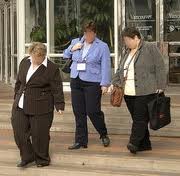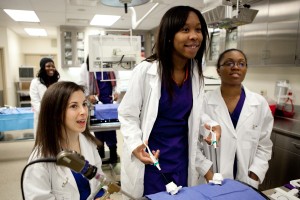 In 2020, the vast majority of adults in America will be overweight or obese and more than half will suffer from diabetes or pre-diabetic conditions, according to projections presented by Northwestern Medicine researchers at the American Heart Association (AHA) Scientific Sessions recently in Orlando.
In 2020, the vast majority of adults in America will be overweight or obese and more than half will suffer from diabetes or pre-diabetic conditions, according to projections presented by Northwestern Medicine researchers at the American Heart Association (AHA) Scientific Sessions recently in Orlando.
The AHA has set a target to help Americans improve their overall heart health by 20 percent in 2020. However, if current trends continue, Americans can expect only a modest improvement of six percent in overall cardiovascular health in 2020.
The implications of not increasing heart health by 20 percent by 2020 are grave. Declining rates of sickness and death from cardiovascular disease may stall, and related health care costs, already projected to reach $1.1 trillion per year by 2030, could rise even further. That’s according to study author Mark Huffman, MD, assistant professor in preventive medicine and medicine-cardiology at Northwestern University Feinberg School of Medicine.
Representative of all Americans, the study is based on patterns found in the National Health and Nutrition Examination Surveys (NHANES) from 1988 to 2008. The projected numbers on weight and diabetes, based on previous trends, follow.
In 2020, 83 percent of men and 72 percent of women will be overweight or obese. Currently, 72 percent of men and 63 percent of women are overweight or obese (people who are overweight have a BMI of 25 to 29, people who are obese have a BMI of 30 or greater). In 2020, 77 percent of men and 53 percent of women will have dysglycemia (either diabetes or pre-diabetes). Currently, 62 percent of men and 43 percent of women have dysglycemia.
“To increase overall heart health by 20 percent, American adults would need to rapidly reverse these unhealthy trends -- starting today,” Huffman said.More people would need to improve health behaviors related to diet, physical activity, body weight and smoking, and health factors, related to glucose, cholesterol and blood pressure.
"We’ve been dealing with the obesity trend for the past three decades, but the impact we project on blood sugar is a true shock,” said Donald Lloyd-Jones, MD, chair and associate professor of preventive medicine at Feinberg. “Those are some really scary numbers. When blood sugar goes up like that all of the complications of diabetes come into play."
Less than five percent of Americans currently are considered to have ideal cardiovascular health. The modest six percent improvement in cardiovascular health that is projected for 2020 means better cholesterol and blood pressure numbers for Americans and fewer smokers. Improvements in treatment and control of cholesterol and blood pressure with medication and declines in smoking would partially account for this small boost, but they wouldn’t be enough to offset the weight and diabetes problems Americans face, Huffman said. Projected improvements in diet and physical activity also contribute to the six percent projection, but the absolute increase in Americans who consume ideal diets will remain less than two percent by 2020, if current trends continue.
“Since the 1960s cardiovascular disease death rates have substantially decreased, but if the weight and dysglycemia trends continue to grow past 2020, we are in danger of seeing those overall numbers start to reverse,” Huffman said.Achieving a healthy weight through diet and physical activity is the best way most Americans can improve their cardiovascular health, but, as Huffman stressed, not smoking is the number one preventable cause of preventable death. Yet, one in five Americans still smoke.
 A new report from the US government released today warns that energy drinks are sending an alarming number of people to emergency rooms.
A new report from the US government released today warns that energy drinks are sending an alarming number of people to emergency rooms.
 Women who regularly drink sugary beverages may be increasing their cardiovascular risk, researchers found. A longitudinal study showed that those who reported drinking at least two sugar-sweetened beverages every day were more likely to gain weight, increase waist size, and develop impaired glucose tolerance, according to Christina Shay, PhD, of the University of Oklahoma in Oklahoma City.
Women who regularly drink sugary beverages may be increasing their cardiovascular risk, researchers found. A longitudinal study showed that those who reported drinking at least two sugar-sweetened beverages every day were more likely to gain weight, increase waist size, and develop impaired glucose tolerance, according to Christina Shay, PhD, of the University of Oklahoma in Oklahoma City.

 In 2020, the vast majority of adults in America will be overweight or obese and more than half will suffer from diabetes or pre-diabetic conditions, according to projections presented by Northwestern Medicine researchers at the American Heart Association (AHA) Scientific Sessions recently in Orlando.
In 2020, the vast majority of adults in America will be overweight or obese and more than half will suffer from diabetes or pre-diabetic conditions, according to projections presented by Northwestern Medicine researchers at the American Heart Association (AHA) Scientific Sessions recently in Orlando. The birth rate for U.S. teens aged 15–19 years hit a record low in 2010, according to a report released on November 17, 2011 by the U.S. Centers for Disease Control and Prevention.
The birth rate for U.S. teens aged 15–19 years hit a record low in 2010, according to a report released on November 17, 2011 by the U.S. Centers for Disease Control and Prevention. November 17, 2011
November 17, 2011 Are you curious about deep frying a turkey? I know you are! You’ve heard all the talk about how tasty they are; tender and juicy yet crispy on the outside. You’ve seen the turkey fryers and giant jugs of peanut oil. But you’re a little nervous. That’s a lot of hot oil! USDA’s Food Safety & Inspection Service has these tips to help you safely prepare a deep fat fried turkey.
Are you curious about deep frying a turkey? I know you are! You’ve heard all the talk about how tasty they are; tender and juicy yet crispy on the outside. You’ve seen the turkey fryers and giant jugs of peanut oil. But you’re a little nervous. That’s a lot of hot oil! USDA’s Food Safety & Inspection Service has these tips to help you safely prepare a deep fat fried turkey. Cooking: Caution! Hot Oil!
Cooking: Caution! Hot Oil! Among patients with type 2 diabetes, women were more likely to have risk factors for chronic kidney disease than men, which may also put them at risk for poorer outcomes, according to at study reported at the American Society of Nephrology held in Seattle.
Among patients with type 2 diabetes, women were more likely to have risk factors for chronic kidney disease than men, which may also put them at risk for poorer outcomes, according to at study reported at the American Society of Nephrology held in Seattle. This sounds like a headline that Jay Leno would satirize on his late night show! Low-income women with children who move from high-poverty to lower-poverty neighborhoods experience notable long-term improvements in diabetes and extreme obesity, according to a new
This sounds like a headline that Jay Leno would satirize on his late night show! Low-income women with children who move from high-poverty to lower-poverty neighborhoods experience notable long-term improvements in diabetes and extreme obesity, according to a new 